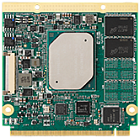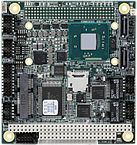 LEC-AL
SMARC Short Size Module with Intel Atom E3900 Series, Pentium N4200 or Celeron N3350 Processor
The LEC-AL Computer-On-Module (COM) combines the SMARC 2.0 standard with the latest Intel Atom E-Series and Pentium and Celeron N-series System-on-Chips (SoCs), providing ideal solutions for low power consumption and high performance requirements. The module provides the high integration, high performance, low power, and ruggedness favored by Internet- of-Things (IoT) applications such as retail transactional clients, digital signage, and in-vehicle infotainment systems. The LEC-AL module utilizes the latest Intel E-series and N-series SoCs, which are based on the Intel 64 Architecture, the new HD Graphics 500/505 engine, and a faster, 4-vector image processing unit. The SoCs are manufactured on Intel’s industry-leading, tri-gate 14nm process, improving system performance by supporting more than 4 GB of both virtual and physical memory.
The module primarily targets embedded intelligent systems used in several vertical market segments such as healthcare, industrial controllers and real-time systems, retail systems, edge IOT gateways, in-vehicle infotainment systems, printers, thin clients, industrial and ruggedized tablets, and many others. The LEC-AL supports contemporary, high-bandwidth interfaces such as Ultra HD HDMI, dual-channel LVDS, PCI Express Gen2, Gigabit Ethernet, USB 2.0/3.0, SATA Gen3, enhanced MIPI CSI camera, and a state-of-the-art HD Audio interface.
The module generates its own LVDS (18/24bit), TMDS, and Display Port ++ video signals using eDP and DDI output from the SoC. Two SPI Flash chips implement a fail-safe BIOS, allowing the user to boot the module even if current BIOS settings have corrupted the system. Under the management of the BMC chip (Board Management Controller), the SEMA utility (Smart Embedded Management Agent) provides system control, security, and failure protection— counting, monitoring, and measuring hardware and software events, and using the SMBus to send corrective commands to the SoC.
LEC-AL
SMARC Short Size Module with Intel Atom E3900 Series, Pentium N4200 or Celeron N3350 Processor
The LEC-AL Computer-On-Module (COM) combines the SMARC 2.0 standard with the latest Intel Atom E-Series and Pentium and Celeron N-series System-on-Chips (SoCs), providing ideal solutions for low power consumption and high performance requirements. The module provides the high integration, high performance, low power, and ruggedness favored by Internet- of-Things (IoT) applications such as retail transactional clients, digital signage, and in-vehicle infotainment systems. The LEC-AL module utilizes the latest Intel E-series and N-series SoCs, which are based on the Intel 64 Architecture, the new HD Graphics 500/505 engine, and a faster, 4-vector image processing unit. The SoCs are manufactured on Intel’s industry-leading, tri-gate 14nm process, improving system performance by supporting more than 4 GB of both virtual and physical memory.
The module primarily targets embedded intelligent systems used in several vertical market segments such as healthcare, industrial controllers and real-time systems, retail systems, edge IOT gateways, in-vehicle infotainment systems, printers, thin clients, industrial and ruggedized tablets, and many others. The LEC-AL supports contemporary, high-bandwidth interfaces such as Ultra HD HDMI, dual-channel LVDS, PCI Express Gen2, Gigabit Ethernet, USB 2.0/3.0, SATA Gen3, enhanced MIPI CSI camera, and a state-of-the-art HD Audio interface.
The module generates its own LVDS (18/24bit), TMDS, and Display Port ++ video signals using eDP and DDI output from the SoC. Two SPI Flash chips implement a fail-safe BIOS, allowing the user to boot the module even if current BIOS settings have corrupted the system. Under the management of the BMC chip (Board Management Controller), the SEMA utility (Smart Embedded Management Agent) provides system control, security, and failure protection— counting, monitoring, and measuring hardware and software events, and using the SMBus to send corrective commands to the SoC.
 LEC-PX30
SMARC Short Size Module with Rockchip PX30 Quad-Core Arm Cortex A35
LEC-PX30 based on power-efficient quad-core Arm Cortex-A35 SoC is a low-power, low-cost, entry-level, small-sized SMARC rev 2.0 module. For applications, such as IoT controllers, IoT gateways, wearable and mobile industrial devices, basic HMI, sensor concentrators, requiring good computing performance at low power consumption (1.5W — 5W) and Linux Yocto capability, LEC-PX30 is an ideal solution.
LEC-PX30
SMARC Short Size Module with Rockchip PX30 Quad-Core Arm Cortex A35
LEC-PX30 based on power-efficient quad-core Arm Cortex-A35 SoC is a low-power, low-cost, entry-level, small-sized SMARC rev 2.0 module. For applications, such as IoT controllers, IoT gateways, wearable and mobile industrial devices, basic HMI, sensor concentrators, requiring good computing performance at low power consumption (1.5W — 5W) and Linux Yocto capability, LEC-PX30 is an ideal solution.
 LEC-IMX8M
SMARC Short Size Module with NXP i.MX 8M
The SMARC («Smart Mobility ARChitecture») is a versatile small form factor computer on Module definition targeting applications that require low power, low costs, and high performance.
The Modules will typically use ARM SOCs similar or the same as those used in many familiar devices such as tablet computers and smart phones.
Alternative low power SOCs and CPUs, such as tablet oriented X86 devices and other RISC CPUs may be used as well. The Module power envelope is typically under 6W.
LEC-IMX8M
SMARC Short Size Module with NXP i.MX 8M
The SMARC («Smart Mobility ARChitecture») is a versatile small form factor computer on Module definition targeting applications that require low power, low costs, and high performance.
The Modules will typically use ARM SOCs similar or the same as those used in many familiar devices such as tablet computers and smart phones.
Alternative low power SOCs and CPUs, such as tablet oriented X86 devices and other RISC CPUs may be used as well. The Module power envelope is typically under 6W.
 Q7-AL
Qseven Standard Size Module with Intel Atom E3900, Pentium N4200 and Celeron N3350 Processor
The Q7-AL Computer-On-Module (COM) combines the QSeven 2.1 standard with the Intel («Apollo Lake») Atom E-series and Pentium and Celeron N-series System-on-Chips (SoCs), providing ideal solutions for low power consumption and high pin/area density requirements. The module provides the high integration, high performance, low power, and ruggedness favored by Internet-of-Things (IoT) applications such as retail transactional clients, digital signage, and in-vehicle infotainment systems.
The QSeven form factor affords a more compact profile and footprint than the other COM platforms. With mechanical dimensions of 70mm width, 70mm length, and 2.3mm of overall height, Qseven ranks as one of the smallest COM standards currently available.
The Q7-AL utilizes the upgrades in Intel’s latest («Apollo Lake») N-series and E-series SoCs such as the Intel 64 Architecture («Goldmont»), the new HD graphics 500/505 engine (Gen-9), and a faster, 4-vector image processing unit. The SoCs are manufactured on Intel’s industry-leading, tri-gate 14nm process, improving system performance by supporting up to 8GB of system memory.
Compared to the previous generation («Braswell»), the Apollo Lake SoC comes with a larger package size (24×31mm2) and pin count (1296 pins) and has updated the OS support by adding Windows 10 IOT and removing support for Windows7/8.1 and WEC7/2013. Because Apollo Lake has more I/O interfaces than Braswell, no pin compatibility exists between these two generations of SoCs.
Q7-AL
Qseven Standard Size Module with Intel Atom E3900, Pentium N4200 and Celeron N3350 Processor
The Q7-AL Computer-On-Module (COM) combines the QSeven 2.1 standard with the Intel («Apollo Lake») Atom E-series and Pentium and Celeron N-series System-on-Chips (SoCs), providing ideal solutions for low power consumption and high pin/area density requirements. The module provides the high integration, high performance, low power, and ruggedness favored by Internet-of-Things (IoT) applications such as retail transactional clients, digital signage, and in-vehicle infotainment systems.
The QSeven form factor affords a more compact profile and footprint than the other COM platforms. With mechanical dimensions of 70mm width, 70mm length, and 2.3mm of overall height, Qseven ranks as one of the smallest COM standards currently available.
The Q7-AL utilizes the upgrades in Intel’s latest («Apollo Lake») N-series and E-series SoCs such as the Intel 64 Architecture («Goldmont»), the new HD graphics 500/505 engine (Gen-9), and a faster, 4-vector image processing unit. The SoCs are manufactured on Intel’s industry-leading, tri-gate 14nm process, improving system performance by supporting up to 8GB of system memory.
Compared to the previous generation («Braswell»), the Apollo Lake SoC comes with a larger package size (24×31mm2) and pin count (1296 pins) and has updated the OS support by adding Windows 10 IOT and removing support for Windows7/8.1 and WEC7/2013. Because Apollo Lake has more I/O interfaces than Braswell, no pin compatibility exists between these two generations of SoCs.
 CM1-BT1
Extreme Rugged PC/104 Single Board Computer
The CMx-BTx is a PC/104-based, Single Board Computer (SBC), fully compliant with the PCI-104 Specification, Version 1.1 and partially compliant with the PC/104 Specification, Version 2.6. PC/104 SBCs are very compact and highly integrated computers. This SBC features the 22nm, Intel Bay Trail SoC.
The board provides a DDR3L SO-DIMM socket, a PC/104 connector, a PCI-104 connector, three USB 2.0 ports, up to two Gigabit Ethernet ports, up to two SATA 3 Gb/s ports, one dedicated HD-Audio panel connector, one VGA port, one LVDS port, up to four COM ports, one mini-PCIe slot (with one USB 2.0 port included).
The CMx-BTx can be run with only 5 volts and is capable of running operating systems like DOS, Windows 7/8 in either 32-bit or 64-bit configuration, Linux, VxWorks, and others. Another feature included on the board is a fail safe BIOS that enables the user to start the module even if the original BIOS is corrupted.
CM1-BT1
Extreme Rugged PC/104 Single Board Computer
The CMx-BTx is a PC/104-based, Single Board Computer (SBC), fully compliant with the PCI-104 Specification, Version 1.1 and partially compliant with the PC/104 Specification, Version 2.6. PC/104 SBCs are very compact and highly integrated computers. This SBC features the 22nm, Intel Bay Trail SoC.
The board provides a DDR3L SO-DIMM socket, a PC/104 connector, a PCI-104 connector, three USB 2.0 ports, up to two Gigabit Ethernet ports, up to two SATA 3 Gb/s ports, one dedicated HD-Audio panel connector, one VGA port, one LVDS port, up to four COM ports, one mini-PCIe slot (with one USB 2.0 port included).
The CMx-BTx can be run with only 5 volts and is capable of running operating systems like DOS, Windows 7/8 in either 32-bit or 64-bit configuration, Linux, VxWorks, and others. Another feature included on the board is a fail safe BIOS that enables the user to start the module even if the original BIOS is corrupted.
 RK-410FS
4U Rackmount Industrial Chassis with 14-slot Backplane
Adlink’s rackmount and wallmount industrial chassis are aligned with integrated subsystem design, service and performance, is optimized for combined motion/vision/IO applications.
RK-410FS
4U Rackmount Industrial Chassis with 14-slot Backplane
Adlink’s rackmount and wallmount industrial chassis are aligned with integrated subsystem design, service and performance, is optimized for combined motion/vision/IO applications.
 RK-110S
1U Rackmount Industrial Chassis supports 3-slot Backplane
Adlink’s rackmount and wallmount industrial chassis are aligned with integrated subsystem design, service and performance, is optimized for combined motion/vision/IO applications.
RK-110S
1U Rackmount Industrial Chassis supports 3-slot Backplane
Adlink’s rackmount and wallmount industrial chassis are aligned with integrated subsystem design, service and performance, is optimized for combined motion/vision/IO applications.
 APS-946XA-EPS12 (80Plus)
Industrial AC Power Supply PS2 Form Factor, 460W
Industrial AC Power Supply PS2 Form Factor, 460W.
APS-946XA-EPS12 (80Plus)
Industrial AC Power Supply PS2 Form Factor, 460W
Industrial AC Power Supply PS2 Form Factor, 460W.

